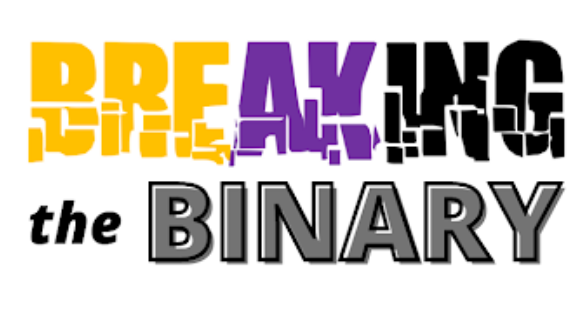Breaking The Binary
May 27, 2022
You’ve probably heard of the LGBTQ+ community before. Maybe you’ve seen a pride parade in town or had a family member come out to you. Maybe you even identify as LGBTQ+ yourself. But do you know what it means to be non-binary? Did you know that 26% of LGBTQ+ youth identify as non-binary? Has a friend ever asked you to refer to them using they/them pronouns? Whether you answered “yes” to any of these questions, are completely lost, or are somewhere in between, keep reading to gain a better understanding of how people understand gender in our society today.
What Does It Mean to Be Non-Binary?
To understand the term non-binary, one must understand what “gender binary” means in the first place. The majority of people identify as either male or female. The prefix bi- means two, and so the word binary corresponds with the distinction between these two gender identities. But for millions of people globally, neither male nor female appropriately describes their gender. While they may be born with male or female as their biological sex, gender identity can be a separate distinction.
When Eastside asked four non-binary and gender non-conforming students at Cherry Hill High School East to share what “non-binary” meant to them, there was a diverse set of responses. (Due to the sensitive nature of LGBTQ+ students’ identities, all student names were changed to pseudonyms, protecting the identities of non-binary students who spoke with Eastside on the condition of anonymity.)
River Goodwin (‘23) said that to them, being non-binary was “a neutral point” among a spectrum of many gender identities.
“To me, it just means that I understand that things are [going to] change with how I feel about my gender in the future,” said Charlie Hawkins (‘23), who further explained that determining each day how they feel about their gender is an important part of their life.
“It means that I don’t have to identify myself as a boy,” Blake Stephens (‘23) explained, saying that they had had a lot of discomfort with that identity in the past and that this personal definition of non-binary was more comfortable for them.
Another student, Sam Porter (‘22) said that to them, non-binary means that “you don’t feel like you fit into the categories that society wants you to fit into.”
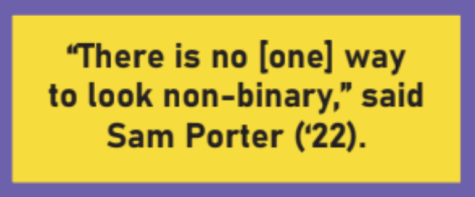
In addition to personal perspectives, the medical and scientific communities have developed perspectives on non-binary identity as it relates to human psychology.
In 2021, that year’s president of the American Psychological Association (APA), Dr. Jennifer F. Kelly, stated “There is a growing body of research that shows that transgender or non-binary gender identities are normal.” Further affirming the validity of non-binary and transgender identities, Kelly said “Attempts to force people to conform with rigid gender identities can be harmful to their mental health and well-being.”
Ultimately, the word non-binary means many different things to many different people. At its core, it is a recognition that for millions of people, who they are cannot be defined by simply being male or female.
Understanding The Identity Spectrum
In the LGBTQ+ community, there are many different identities: lesbian, gay, bisexual, transgender — the list goes on. Non-binary is one of those identities, and it, too, includes additional layers. Within the non-binary community, there is a whole spectrum of ways in which people can identify their gender. All of them center around the central idea that gender is not a simple determination of male or female. So what other ways do people define their gender?
One gender identity that can fall within the non-binary spectrum is “agender.” People who identify as agender generally do not feel as though their identity aligns with any gender. Some agender people feel that they have no gender at all; others may not make that determination, but still express themselves as gender-neutral.
Another two non-binary gender identities are bigender and genderfluid. For bigender people, their gender can often be expressed as both male and female; ultimately, being bigender simply means that someone identifies with gender in two different ways. Genderfluidity, while similar, is more indicative of a shift that one person experiences between multiple gender identities. Someone may feel more masculine one day, and wish to express themselves more femininely the next.
“It’s very fluid. I go through months where I’m severely uncomfortable with being seen as feminine, and then there are some months where I feel hyper-feminine,”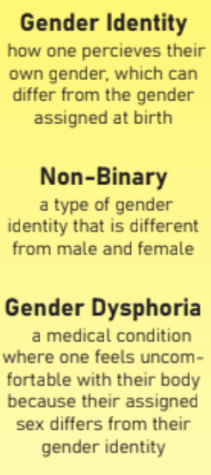 Hawkins said of their experiences with fluctuations in gender identity.
Hawkins said of their experiences with fluctuations in gender identity.
Additionally, some people identify with male or female gender, but use the prefix “demi-” to indicate that they only partially or sometimes feel that way. These people often identify themselves as non-binary as well.
Ultimately, there are far too many nuances to the spectrum of gender to list every possible term with which someone may identify. Gender identification is a complicated psychological experience, and an even more complex construct within American society. The term “non-binary” serves as an umbrella term that can represent every person who does not align with one binary gender or the other. Additionally, for some people “non-binary” can be an identity in itself, with no further specification needed beyond the fact that their gender does not fit within traditional gender norms.
Goodwin, who described their gender identity as non-binary said, “I kind of just feel like this middle-ground neutral.”
Presentation and Expression
In today’s society, many feel pressured to present themselves as either female or male. For those who identify as non-binary, the idea of finding a way to present their gender to others can be a daunting task.
Oftentimes, presentation of gender centers around how others perceive a person, which may not correlate with how they feel on the inside. Traditionally, there are certain characteristics that have been widely perceived as masculine or feminine: masculine muscular builds, feminine long hairstyles, and more.
However, as explained by Porter, “there is no [one] way to look non-binary.” Non-binary people express themselves in all kinds of different ways, and may want to appear conventionally feminine, masculine, or somewhere in between.

“To me it’s very important to understand how I want to present for the day, because if I don’t present in the way that I feel on the inside, it makes me feel anxious and uncomfortable. It just feels like you’re in the wrong body,” said Hawkins.
One of the ways people, including those who identify as non-binary, can express their gender is through how they dress. That can change from day to day, and may even serve as a helpful tool of exploration for those who are still trying to figure out their gender identity.
Hawkins said, “I felt both like a boy and a girl at the same time, and I didn’t know how to express that, [and] it took me going to Goodwill and buying new clothes to figure it out.”
Another method of gender expression can involve physical changes to a person. Some people may choose to change their hair — growing it out, cutting it, or trying a new style — in order to present themselves in alignment with their feelings about gender. Others, especially among non-binary adults, may seek to alter their bodies, taking hormone treatments or getting gender-confirming surgeries, such as top surgery. For younger individuals, puberty blockers can be a treatment option that make no permanent body changes, but delay the onset of natural body developments that may contrast with one’s desired presentation.
Advocates emphasize that identity and expression/presentation are not the same thing. While they are, of course, directly related and often aligned, some people may not be comfortable expressing themselves in a way that matches how they feel in terms of their identity.
The Impact of Representation
In recent years, more and more controversy has arisen over the inclusion of LGBTQ+ people in the media. From controversy over LGBTQ+ dancer Jojo Siwa appearing on Nickelodeon, to debates in Florida over state law’s stance towards LGBTQ+ education, representation has faced increasing scrutiny. As a community that often lacks awareness and understanding from the general public, non-binary people are particularly impacted by battles over-representation.
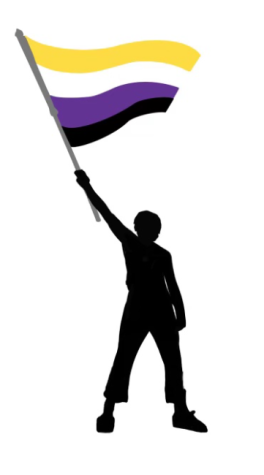
In 2016, an Indiana woman’s story about the impact of representation went viral and garnered media attention. As a worker at a comic book store, she encountered a young LGBTQ+ woman who was looking for a copy of Supergirl. Breaking down in tears, the young woman explained that seeing the televised version of the comic had saved her life; after attempting suicide and experiencing severe mental health crises, she found new hope in the stories of LGBTQ+ people finding happiness that she saw on TV.
“Representation matters more than ever as people turn to entertainment storytelling for connection and escape,” Sarah Kate Ellis, the president of the LGBTQ+ advocacy group GLAAD, said in 2021. With the COVID-19 pandemic and other societal trends increasing the influence of technology, she explained, so too is the importance of media representation increasing.
Various forms of representation for non-binary people, and for LGBTQ+ people more broadly, have recently faced attacks. In 2021, according to the American Library Association, the book “Gender Queer” by Maia Kobabe was the most challenged book of the year. That means that across the country, teachers and librarians faced claims that the book was not appropriate for people to access and thus should be banned. The book specifically addresses Kobabe’s experiences with non-binary gender, as Kobabe uses the pronouns e/em/eir and does not identify as male or female. It has been removed from libraries across the country on the basis that its illustrations, which include depictions of LGBTQ+ people that some consider explicit, are inappropriate.
“There are people for whom this is vital and for whom this could maybe even be lifesaving,” Kobabe said of their book.
Many other LGBTQ+ books, including those like Kobabe’s that address non-binary gender, have faced challenges and bannings in recent years. Additionally, the inclusion of LGBTQ+ people in television, cinema, and other forms of media has repeatedly stirred controversy.
For non-binary people, the fight to include their voices and experiences in popular culture and media is an ongoing struggle. This, among other issues, can contribute to non-binary people feeling unwelcome. However, there are some hopeful developments. For example, popular music artists Sam Smith and Demi Lovato have come out as non-binary and used their platforms to advocate for equality. Seeing them living openly in the world may help create some of the positive impacts of representation that can otherwise be challenging for non-binary people to find.
Pronouns: The How And The Why
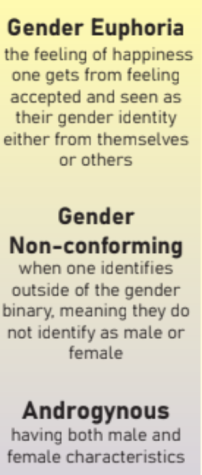 How can such little words make such a big impact? For non-binary people, personal pronouns can really matter. Because personal pronouns involve gender (“she” typically being female, “he” being male,) using the pronouns that someone prefers can be important to affirming their gender. On the other hand, when people refuse to use non-binary individuals’ pronouns, harm can be inevitable
How can such little words make such a big impact? For non-binary people, personal pronouns can really matter. Because personal pronouns involve gender (“she” typically being female, “he” being male,) using the pronouns that someone prefers can be important to affirming their gender. On the other hand, when people refuse to use non-binary individuals’ pronouns, harm can be inevitable
For many non-binary people, they/them pronouns work best. While those pronouns are also used to refer to multiple people at once, the gender-neutral use of they/them pronouns to refer to a singular person dates back as far as 1386, when it was first seen in English literature. When someone identifies as non-binary, they may not want to use he/him or she/her pronouns because those pronouns could suggest they identify with a gender that they really do not.
Many others use a combination of pronouns, such as he/they or they/she. These combinations can indicate that someone is comfortable with multiple sets of pronouns, or that they would like to use gender-neutral pronouns but also are okay with gendered ones. When you encounter someone who uses multiple pronouns, it is best practice to try to incorporate each pronoun in different discussions involving that person. For example, one day you might say “Did Ryan pick up their things?” in one conversation, and “I thought Ryan would be back by now, where is she?” in another. Also, be sure to ask people how they prefer that you use their pronouns; each person’s experience is unique and deeply personal, so taking care to respect each person’s preferences can be validating.
One additional type of pronouns that people have used for decades are called neopronouns. These include pronouns that go beyond he/she/they, such as ze or e. People use these pronouns as an alternative to the options that exist in conventional English because that conventional language may not include pronouns that reflect how they feel.
Pronouns matter because their usage can impact the experiences of gender non-conforming people around you. And for some, it could even impact their mental health and their life as a whole.
The Importance Of Understanding
In 2020, the Trevor Project, a nonprofit advocacy group, conducted a nationwide survey of LGBTQ+ youth. What they found was alarming — more than half of transgender and non-binary youth had seriously considered attempting suicide within the past year. In 2021, the survey was repeated; there was no improvement as once again, more than half of this marginalized group had considered suicide.’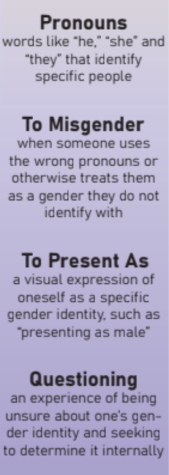
Why are so many people — specifically kids, among the most vulnerable individuals in society — struggling so deeply? The answer can be surprisingly simple. In that same survey, the Trevor Project found a variety of ways to reduce the risk of suicide for gender non-conforming youth. LGBTQ+ youth who had their pronouns respected by the people around them were less likely to consider suicide, and also less likely to attempt it. The same was true of those who were able to change their name if desired, and LGBTQ+ youth who had access to welcoming spaces. Clearly, there are ways to protect LGBTQ+ youth. The persistence of their struggles can thus be attributed to the actions of some people in society who fail to provide that kind of support.
If everyone respected young people’s pronouns, affirmed their identities, and made them feel welcome, more LGBTQ+ youth would be alive today. That is the critical nature of the kind of understanding that can only be attained through a dedication to reading, learning, and talking about the experiences of non-binary people. If you can take what you read here today and expand upon it — asking questions, seeking information, and providing support — the world will be a better place for millions of young people. They’re counting on you.
